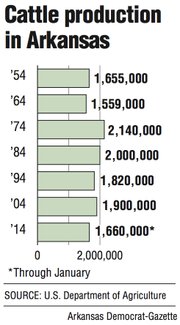Cattle numbers in Arkansas are increasing, bucking a downward trend across much of the U.S., according to the U.S. Agriculture Department’s National Agriculture Statistics Service.
After two years of drought, uncertainty still looms for Arkansas cattle producers this year, but many are optimistic about the future, which is evident in their increased cattle buying.
As of January, when the latest survey was conducted, the state’s cattle population, including calves, was 1.66 million, a 60,000 increase from the same time last year, according to the federal agency. Beef cows increased to 882,000, up from 851,000 last year.
In 2013, the number of cattle in Arkansas declined to 1.6 million from 1.9 million in 2010, a 16 percent decrease.
Gary Proctor, a farmer from Lincoln, was concerned last year that he would not be able to find replacements after he had to sell half of his herd because of lack of water and grass for feed. But in January, he was able to purchase 75 head to begin rebuilding his inventory.
Proctor intended to buy 100 cattle, but prices per head are high now and he settled for 75.
“It’s taking more money to replace them,” he said Tuesday. “The cattle we sold and the cattle we are buying back now is $700 higher.”
Currently, cattle are selling for $2,000 a head, compared with $1,500 to $1,800 four months ago.
Arkansas cattlemen’s revved-up buying has helped increase the state’s inventory by 4 percent.
That’s not the case in the rest of the nation, where ranchers have kept herds low because of several years of adverse weather and high production cost, according to the National Agriculture Statistics Service. Nationally, the cattle population dropped to 87.7 million this year, a 7 percent decrease from 93.8 million in 2010.
Cattle counts vary by month, and population data generally have a six-month lag because the National Agriculture Statistics Service conducts surveys only twice a year, in January and July.
“We need another observation to confirm, but based on the change from last year, Arkansas is one of a few states that reported an increase,”Travis Justice, executive director for the Arkansas Beef Council, said Wednesday.
“Arkansas’ numbers look as if we’re trying to rebuild the cow herd - we’re one of the few states doing that,” he said. “Because 2013 was a better grazing year, we have the growing conditions to make it happen.”
For the trend to continue, said Tom Troxel, a University of Arkansas animal-science professor, two things have to happen: “regular rainfall and low feed cost.”
“We have an advantage. We have good natural resources and, as long as we get rain, the pastures will respond well,” Troxel said Tuesday. “It’s different from Western range lands, which take much longer to regrow.”
Also, corn costs have dropped drastically to $4.25 a bushel, down from $8 a bushel at this time last year. Feed costs depend on the cost of corn, so lower prices are beneficial to ranchers who are trying to rebuild their herds.
But the weather has to cooperate for ranchers to succeed.
“Everybody’s worried about the weather because what makes Arkansas is moisture conditions for grazing capacity,” Justice said. “With normal moisture, we’re poised to have a productive year in Arkansas.”
Business, Pages 25 on 02/27/2014
